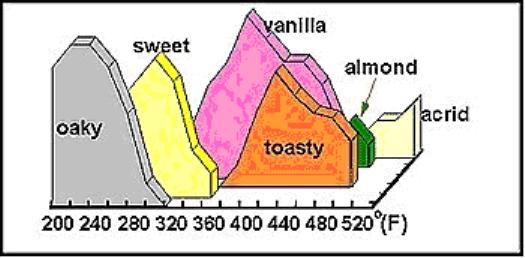Toasted Oak Cubes - by gregscsu
Toasting oak cubes can give a beer interesting flavors that cannot be obtained any other way. Using this chart, determine what kind of flavors you want and at what temperature they come out. The y-axis shows the amount of each flavor produced at a specific temperature.
Toast the oak cubes in the oven at the desired temperature for about 3 hours
Additional toasted oak information:
Toasting of the oak creates melanoidins:
- Heat breaks down carbohydrates into sugars in the wood
- Heavier toasts create maliards and charring, also confectionary compounds (custard/caramel/butterscotch flavors)
Does wood character remain stable or deteriorate over time?
- It does lessen to some extent, it is slow though
- Tannins (good body and mouthfeel) can come from wood
- Oak chips last about 2 weeks before tannins start to leach into the beer (body/complexity tannins) too long and it can become astringent (bad tannins, sour puckering). Can also add to dryness of finish
- “Doing it right” requires slow dosing of your beer over the course of months
- Higher alcohol beers possibly draw out more compounds form the wood.
Preparing your wood for the beer:
- Usually just throw the wood in (no sanitary steps)
- Some people put wood in water in microwave (steam)
- Some people boil water, throw chips in, shake a little, let cool, throw juice and wood in
fermenter. (Jamil sometimes pressure cooks his wood)
- Usually only sanitize for long aging beers (never any chemicals like starsan, iodophor)
- Brett (and other sour critters) can live in wood (takes a long time to become problematic)
- You can pasteurize the wood at 170 F for 5 min.
How much oak is used for a 5 gal batch?
Cubes: (impart flavor much slower) for aging after primary (in keg) use about 1-2 oz in 5 gal for 5 months to 1 year
- The longer the beer sits on the cubes, it penetrates deeper causing a variety of flavors
- The more oak you apply, the shorter amount of time it takes to show itself
- The flavor is different depending on amount placed and time left
- The flavors that come out first from the oak only become more defined with age
- It takes 3-4 weeks to notice flavors are melding (especially with cubes)
- Vanilla and caramel are first, then spices and cloves later on
- Toasted coconut for lighter toast oak
- Oak cubes will dissolve to “little nubs” after 1½-2 years of keeping them in a keg (Jamil did this with an English Barleywine, which became an award winning beer)
- Too little oak for too long creates bad tannins
- Too much oak does not create complexity of flavors before it becomes overwhelming (varies between different styles of beer)

